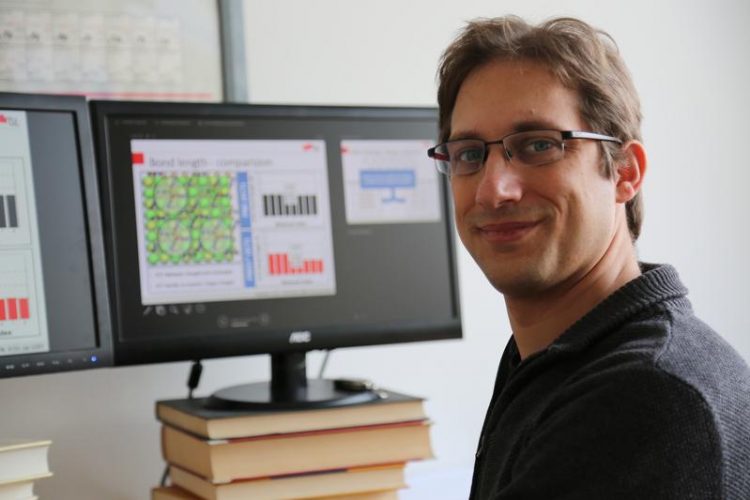Machine learning methods provide new insights into organic-inorganic interfaces

By combining two new machine-learning methods, TU Graz physicist Oliver Hofmann was able to refute theories on long-range charge transfer between organic and inorganic materials. © Birgit Baustädter – TU Graz
Oliver Hofmann and his research group at the Institute of Solid State Physics at TU Graz are working on the optimization of modern electronics. A key role in their research is played by interface properties of hybrid materials consisting of organic and inorganic components, which are used, for example, in OLED displays or organic solar cells.
The team simulates these interface properties with machine-learning-based methods. The results are used in the development of new materials to improve the efficiency of electronic components.
Long-range charge transfer as a subject of investigation
The researchers have now taken up the phenomenon of long-range charge transfer. A transfer of electrons from one material to another already occurs in the switched-off state if there are energetically more favourable states for the electrons in the neighbouring material.
This raises the fundamental question of how far this transfer of electrons can extend in organic material, i.e. how many layers it encompasses. Many studies report that for organic-inorganic interfaces this effect is limited to the first layer, i.e. the layer where the (organic) molecules are in direct contact with the (inorganic) metal surface.
On the other hand, some reports assume that the effect also extends over longer distances, to the second layer or beyond. “If this is the case, the effect could be used to reduce the electrical resistance of the hybrid material, making it more energy efficient,” says Hofmann, explaining why it is so interesting.
New examination method combines two machine learning methods
In order to demonstrate long-range charge transport in organic-inorganic interfaces, the researchers used the new machine learning methods SAMPLE and BOSS to investigate a copper-tetracyanoethylene interface (TCNE/Cu(111)), “since there are particularly strong experimental data available here that indicate long-range charge transport,” said Hofmann.
There is no clear theory why some systems show this effect. Hofmann and his team wanted to “solve this mystery in order to create a basis for how to produce materials with the same property.”
By combining both methods, the researchers were able to identify over two million potential interface structures for the TCNE-Cu interfaces and predict the behaviour of the molecules under various experimental conditions. Surprisingly, the results showed that there is no long-range charge transfer, but instead the molecules in the system change their structure.
Molecules change their atomic arrangement
When molecules are applied, usually they retain their general arrangement and pack more closely until, at a certain density, they finally start growing the second layer. In the TCNE/Cu(111) system, however, the adsorbed molecules change from the original lying position to a standing one after a certain amount has been deposited. They thus straighten up in order to be able to crowd even closer together.
“However, standing molecules have a completely different charge transfer than lying molecules. The structural transformation is difficult to detect experimentally, but the measurement results are similar to those of long-range charge transport,” explains Hofmann.
The investigations refute the hypothesis of long-range charge transfer. The use of the combined machine learning methods SAMPLE and BOSS is intended to support future experiments in material development in such a way that such misinterpretations no longer occur.
By taking a deeper look into the physical processes, the new processes help to ensure that materials are no longer designed to chase an effect that does not exist in this form. Hofmann underlines the advantage of the new method: “Thanks to the two methods, millions of different structures can be simulated in the future.”
The TU Graz researchers recently published details of the study in Advanced Science (https://doi.org/10.1002/advs.202000992).
Details of the machine learning software
SAMPLE (https://www.if.tugraz.at/web.en.php?85) was developed by the Hofmann Group and used for the first time for material design as part of these investigations. BOSS (https://pypi.org/project/aalto-boss/1.0/) is an ML-Software of the Rinke Group at the Aalto University (Finland). Both methods are available as open source software.
For his work in the field of material design Oliver Hofmann was awarded the START Prize 2018 of the Austrian Science Fund FWF (https://www.tugraz.at/en/tu-graz/services/news-stories/tu-graz-news/singleview/a…). A portrait of the TU Graz physicist can be found on Planet Research (https://www.tugraz.at/en/tu-graz/services/news-stories/planet-research/singlevie…).
This research project is anchored in the FoE “Advanced Materials Science” (https://www.tugraz.at/en/research/fields-of-expertise/advanced-materials-science…), one of the five Fields of Expertise of Graz University of Technology.
Oliver HOFMANN
Dipl.-Ing. Dr.techn.
TU Graz | Institute of Solid State Physics
Petersgasse 16/II
8010 Graz
Phone: +43 316 873 8964
o.hofmann@tugraz.at
Charge Transfer into Organic Thin Films: A Deeper Insight through Machine‐Learning‐Assisted Structure
Alexander T. Egger, Lukas Hörmann, Andreas Jeindl, Michael Scherbela, Veronika Obersteiner, Milica Todorović, Patrick Rinke, Oliver T. Hofmann
Adv. Sci. 2020, 2000992
Doi: https://doi.org/10.1002/advs.202000992
Media Contact
All latest news from the category: Materials Sciences
Materials management deals with the research, development, manufacturing and processing of raw and industrial materials. Key aspects here are biological and medical issues, which play an increasingly important role in this field.
innovations-report offers in-depth articles related to the development and application of materials and the structure and properties of new materials.
Newest articles

First-of-its-kind study uses remote sensing to monitor plastic debris in rivers and lakes
Remote sensing creates a cost-effective solution to monitoring plastic pollution. A first-of-its-kind study from researchers at the University of Minnesota Twin Cities shows how remote sensing can help monitor and…

Laser-based artificial neuron mimics nerve cell functions at lightning speed
With a processing speed a billion times faster than nature, chip-based laser neuron could help advance AI tasks such as pattern recognition and sequence prediction. Researchers have developed a laser-based…

Optimising the processing of plastic waste
Just one look in the yellow bin reveals a colourful jumble of different types of plastic. However, the purer and more uniform plastic waste is, the easier it is to…



